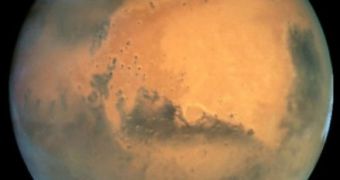According to simulations of clouds present in Mars' atmosphere, they contain less water than previously calculated. Similar clouds of water ice form on Earth, though on Mars they are created at temperatures below 100 degrees Celsius, and are extremely difficult to replicate in controlled conditions at such low temperatures.
The simulations where made at NASA's Ames Research Center, by Tony Colaprete, revealing that particles forming in these clouds are relatively large as compared to the ones expected, meaning their added weight determines them to fall quicker on the surface of the planet, thus increasing the dryness of the atmosphere.
Previous theories regarding Mars' atmosphere predicted that these clouds form in 100 percent relative humidity conditions, however further studies showed that for them to form a supersaturated environment is needed. Colaprete argues that in order to understand the past climes of the Red Planet, a more detailed study of the processes that take place during Martial cloud control and water cycle is needed, since considering that Mars' clouds form and behave in the same way as those on Earth is an incorrect assumption.
Mars' clime is dominated by its water cycle. As it travels on the orbit around the Sun, is may tilt its northern ice cap towards the Sun determining it to heat up and evaporate part of the water ice into the atmosphere, which then is transported towards southern regions, and ultimately to the south pole. The exact reverse process takes place when summer takes over the south pole clime.
This implies that Mars' water content in the atmosphere greatly varies in space and time, and is mostly controlled by the clouds that migrate between the two poles of the planet. As water vapors reach the colder regions of the south pole during the northern summer, they condense to the surface and freezes, forming an alternating water cycle that repeats itself every year. According to Colaprete, if all the water contained in Mars' atmosphere were to freeze on the whole surface, it would form a layer of ice only one-fifth of a human hair thin.
Though the water content in a Martian cloud could be responsible for as much as 10 to 20 percent of the mass, its atmosphere is highly sensitive to the influence of this type of clouds.

 14 DAY TRIAL //
14 DAY TRIAL //